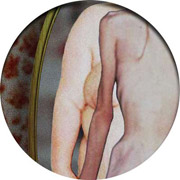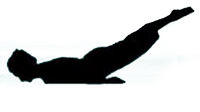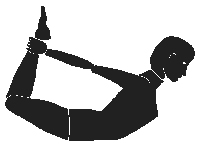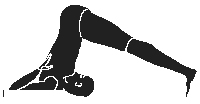Introduction

People with anorexia continue to think they are overweight even after they become extremely thin, are very ill or near death. Often they will develop strange eating habits such as refusing to eat in front of other people. Sometimes the individuals will prepare big meals for others while refusing to eat any of it. In the U.S. and other countries with high economic status, it is estimated that about one out of every 100 adolescent girls has the disorder. Caucasians are more often affected than people of other racial backgrounds, and anorexia is more common in middle and upper socioeconomic groups. According to the U.S. National Institute of Mental Health (NIMH), an estimated 0.5% to 3.7% of women will suffer from this disorder at some point in their lives.
Baldness and Anorexia
Eating disorders are triggered by a complexity of factors including social, biological, psychological and behavioral items. Yoga can be a great tool and should be utilized in treating eating disorders. That doesnt mean we stop getting help from the professional medical world. But what we can do is to have the best of both worlds; the medical field of brilliant minds and the intuitive and spiritual world to help us calm our mind and lift our spirit. A calm and focused mind has a better chance of reducing the harmful effects of eating disorders. Yoga has been proven to reduce depression and recreate a state of balance and well being. Different yoga practices encourage heightened levels of self esteem and promote a positive view of your own body. This is a crucial factor in eating disorders and has been shown to significantly increase recuperation and healing. Yoga can also promote self-esteem and a positive body image, which play primary roles in eating disorders, through the cultivation of non-judgment, confidence, self-acceptance, openness and inner strength. Physically, a regular yoga practice can help rebuild the strength, energy and bone density that is damaged and lost with Anorexia. As the mental component plays an important role in eating disorders, meditation can reduce harmful thoughts and feelings. The yoga poses work best when the exterior elements are left aside and concentration focuses on inner aspects of yourself.YOGA POSES FOR ANOREXIA
Crab Pose
Crab posture opens the chest and tones the low back to stimulate the respiratory and endocrine systems. Crab pose also builds arm, leg and core body strength. The Crab Pose is a beginner's back bend. Back bends strengthen the back and chest and improve spinal flexibility. They are practiced toward the end of a yoga class or home practice, between seated forward bends and inversions.Pigeon Pose
Yoga pigeon pose provides a deep stretch for the buttocks and outer thigh muscle. There are several variations such as forward bending, reclining and seated pigeon. A yoga pose that will stretch your hips and thighs and back.Locust Pose
The locust pose, or Salabhasana in Sanskrit, is an energizing pose that strengthens the abdominal muscles. Locust yoga pose will build strength in the lower back and lengthen the spine. The locust Pose is often recommended as a precursor to poses that are very demanding in terms of flexibility. This is because the Locust Pose is one of the best postures to strengthen the back.Mountain Pose
The Mountain Pose is also extremely useful because it is also ideal as preparatory or resting yoga pose. The Mountain Pose also offers benefits in terms of physical fitness, as it strengthens the thighs, knees, and ankles. It also tones the muscles around the abdomen and buttocks.Goddess Pose
Relaxing in Goddess Pose is a really great way to come into your centered breathing and be able to feel the expansion of the rib cage. Restorative Poses, like Goddess Pose are a boon to your practice when you are not feeling your best or just want do some passive stretching. These poses make use of props to support the body and allow it to open in new ways.Squat Pose
This pose is very useful for easing the tension from the lower back. Practicing this pose regularly, improves balance, coordination and concentration. This pose is a transition from seated to standing poses. Since squat pose opens groin and hips, it is a very good prenatal exercise.YOGA ASANAS FOR CERVICAL SPONDYLOLYSIS
MATSYASANA

Steps
- Sit with your legs fully stretched out. Bend each leg at the knees and place your feet on the other hip joint. Both the heels are adjusted in such a way that each presses the adjacent portion of the abdomen. This forms the foot-lock in a sitting position.
- Bend backwards and, exhaling, rest your weight on the elbows. Push your neck backwards and slightly rise the hip upward thus making an arch of the spine.
- Then, by making hooks of the forefingers, hold your toes on the corresponding side without crossing your arms. This posture should be maintained for some time with slow and deep breathing.
- For reverting to the original position, release the foot-lock and return to the supine position by lowering the arch.
SHIRSHASANA

Steps
- Sit on soles. place knees on the ground.
- Frame finger lock with both hands.
- Making a triangle from finger-lock and elbows, place it on ground.
- Now straighten your legs.
- Slowly bring the legs neck your body.
- Soles will automatically leave the ground by practice and thighs knees will touch the abdomen.
- Now keeping the balance straighten your legs from thigh-joint, knees will remain folded.
- Now straighten the knees also and completely balance your body on head.
- While returning to the original position fold your knee first. Then fold your legs from thigh and let the thigh and knee touch your abdomen.
- Now slowly place the soles on the ground. Slowly raise your head also and sit on soles.
SARVANGASANA

The Sarvanga Asana is one of the most treasured asanas, said to benefit the whole body. In this asana the whole body weight rests on the shoulders and the neck and upper back regions are stretched to the limit. Beginners should practice the sarvanga asana in a moderate way and gradually attempt the full posture.
Steps
- Lie straight, on your back on the floor. Palms should be on the floor close to the body and the heels and the toes should be together.
- Inhale and raise both the legs slowly up in a vertical position (at 90o). Raising of the legs should be synchronized with the breathing.
- Exhale and again raise the legs upward from the second position. Bring both palms underneath the hips and should be used to assist in raising the body upwards. The hands should always work as a support to the body weight.
- Try to raise the body as straight as possible.
- At the final stage of this asana you will be resting on your shoulders, chin touching the chest. In this position the legs should be stiff hard and together and the toes is pointing towards the ceiling. Do not shake. Be firm and keep breathing normally.
- Remain in this position for about 30 seconds on the first day.
- For returning to the first position, first fold the legs on the knees. Your heels should be now on the thighs and above the buttock. Then slowly let the body return to the floor while the palms are supporting the body weight.
- Now stretch out the legs forwards and relax. You have completed one round of the Sarvanga Asana.
SALABHASANA

Steps
- First rest in Makarasana. Then keep the hands below thighs and raise up both the legs together.
- The legs should be as straight as possible.
- Inhale and remain in this posture for a few seconds and then relax.
- Repeat this three to six times initially. After gaining sufficient experience you can remain in Shalabhasana for a longer duration, at a stretch.
- For easy practice start with each leg separately for six times. Then you can try raising both the legs.
DHANURASANA
This asana strengthens the abdomen, especially around the navel, and the chest muscles. It improves the flexibility of the arms, shoulders, thighs, legs, lower back and abdomen. The spine also becomes healthy and strong. It is good for relieving flatulence, constipation and menstrual irregularities. It also prevents sterility.
Steps
- Take prone lying position, legs together, hands straight by the side of the thighs, chin resting on the ground. Fold the legs at the knees and bring them on the thighs. Knees must remain together.
- Bring your hands backward and hold the toes of respective legs from the thumb and forefinger of the respective hands.
- Raise your legs a little up and simultaneously raise your head and chest.
- Holding the toes pull the legs towards ears and bring the toes near the ear. Gaze in front.
- While returning to this original position, loosen your hands, take legs backward, let the thighs touch the ground, leave the toes and ultimately bring the legs and hand to the first position
PASCHIMOTTANASANA

Steps
- This posture involves stretching of the posterior muscles of the body.
- While sitting, stretch your legs forward and keep them close to each other. Bend a little forward, make hooks of your fingers and hold the big toes on the respective sides.
- While exhaling, bend forward stretching the trunk along the thighs. Rest your on the knees, which should be kept straight.
- Gradually, the tense muscles can be made supple for securing the complete posture. Inhale and return to the original position
HALASANA

Steps
- Lie on your back inhale to your fullest and lift your legs and trunk first to 30 degree, then 60 degree and finally 90 degree just as in sarvangasana, then take your legs back of your head making it 120 degree and beyond, this process should be done while exhalaling.
- Now rest the toes on the ground behind the head and breath normally, you can use hands on the back for support but ideally both in sarvangasana and halasana hands should be on flooe, palms touching the floor.
- When acquiring the posture of halasana the legs should be at 30 degree from the floor.
- Same process is done in reverse order while returning to normal position.
Diseases Related to Cancer |
||


